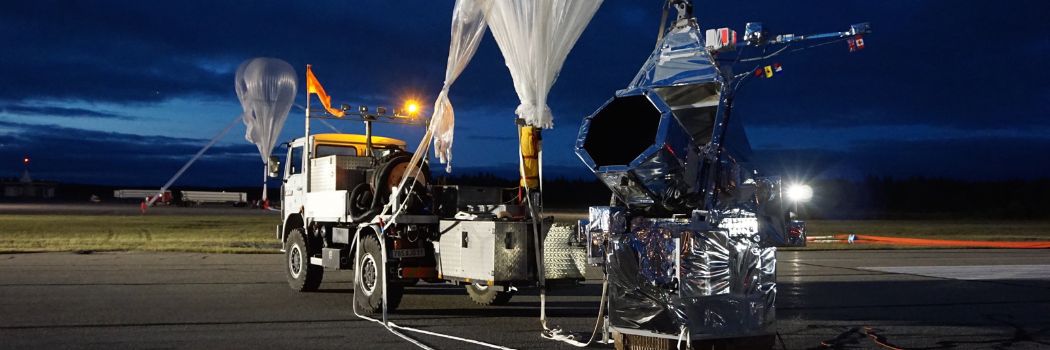SuperBIT makes Nature Astronomy front cover

An international project involving Durham University which flew a gigantic balloon-borne telescope to the edge of space has made the front cover of the prestigious journal Nature Astronomy.
Our astronomers are part of the team behind the Superpressure Balloon-borne Imaging Telescope (SuperBIT).
Helium balloon
Writing in Nature Astronomy the research team has set out how the 0.5 metre, two tonne SuperBIT telescope was lifted to the stratosphere by a helium balloon the size of a small stadium in April last year.
SuperBIT circumnavigated the globe five times in 40 days, and obtained high-resolution, diffraction-limited optical and near-ultraviolet imaging from above 99.5 per cent of Earth’s atmosphere.
It returned stunning images of space including the Tarantula Nebula - a neighbourhood of the Large Magellanic Cloud where new stars are being born - and the collision between the Antennae galaxies.
Dark matter
SuperBIT also mapped the distribution of dark matter in 30 pairs of colliding galaxy clusters, selected during the flight by autonomous software.
Durham’s Institute for Computational Cosmology has now predicted the appearance of those galaxy clusters, with a variety of different candidates for dark matter.
Comparing simulated and real observations will tell the researchers what real dark matter is made from. Their analysis is under way.
GigaBIT telescope
SuperBIT takes high-resolution images like those of the Hubble Space Telescope, but with a wider field of view.
Funding has already been secured for the 1.4 m GigaBIT telescope, which will improve on SuperBIT’s sensitivity and resolution.
Find out more
- Read more about the project in Nature Astronomy and see SuperBIT on the front cover of the February 2024 issue (Vol. 8, issue 2, Feb 2024, page 1, Springer Nature).
-
Durham’s lead researcher on SuperBIT is Professor Richard Massey, in our Department of Physics. Richard is a member of Durham’s Institute for Computational Cosmology and Centre for Extragalactic Astronomy.
-
Our Department of Physics is a thriving centre for research and education. Ranked 2nd in the UK by The Guardian University Guide 2023, and in the World Top 100 in the QS World University Rankings by Subject 2023, we are proud to deliver a teaching and learning experience for students which closely aligns with the research-intensive values and practices of the University.Feeling inspired? Visit our Physics webpages to learn more about our postgraduate and undergraduate programmes.
-
SuperBIT is a collaboration between Durham University the University of Toronto, Canada, Princeton University, USA, and NASA.
-
Funding for the SuperBIT mission has been provided by NASA, the Canadian Space Agency, and the Royal Society.
Main picture credit: Barth Netterfield (University of Toronto)


/prod01/prodbucket01/media/durham-university/departments-/physics/teaching-labs/VT2A9034-1998X733.jpeg)
/prod01/prodbucket01/media/durham-university/central-news-and-events-images/news/SuperBIT-gallery-4.jpg)
/prod01/prodbucket01/media/durham-university/central-news-and-events-images/news/Copy-of-SuperBIT-gallery-3.jpg)
